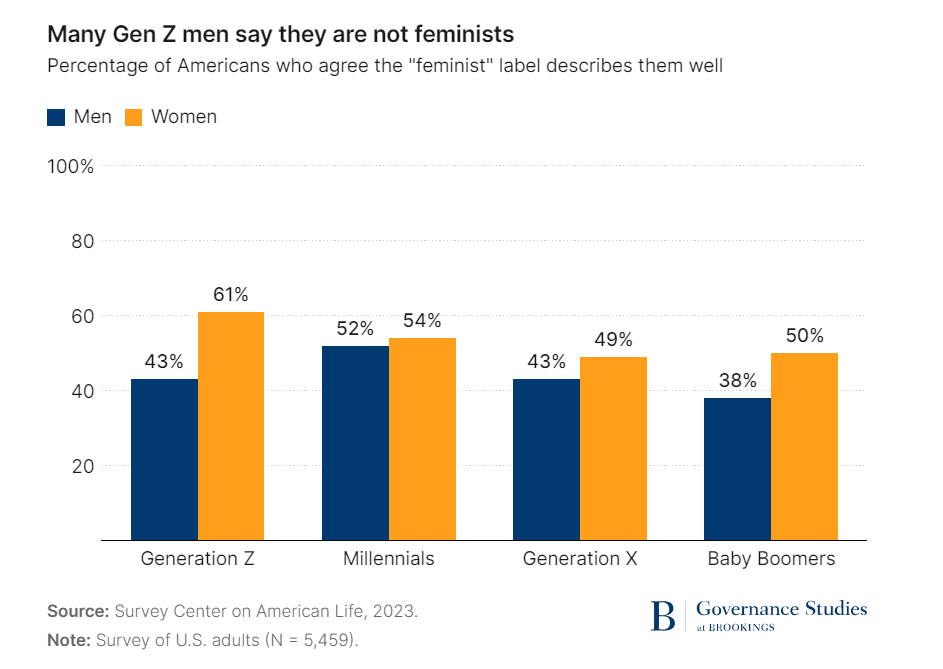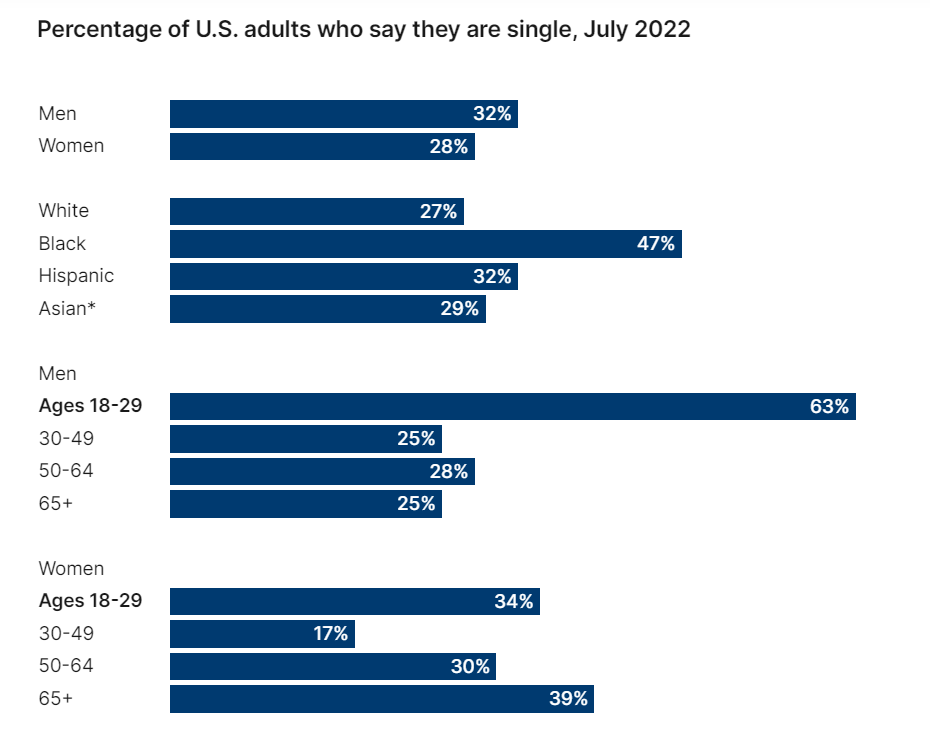Welcome to DU!
The truly grassroots left-of-center political community where regular people, not algorithms, drive the discussions and set the standards.
Join the community:
Create a free account
Support DU (and get rid of ads!):
Become a Star Member
Latest Breaking News
Editorials & Other Articles
General Discussion
The DU Lounge
All Forums
Issue Forums
Culture Forums
Alliance Forums
Region Forums
Support Forums
Help & Search
General Discussion
Related: Editorials & Other Articles, Issue Forums, Alliance Forums, Region Forumsit is a large drop off (likely male-driven) for my age cohort (I am 27yo) from 2020 & the 2022 & 2018 midterms
There is a growing cleavage within Gen Z, with Gen Z females remaining very pro Dem, but Gen Z males starting to move towards the RW at a greater rate
You can start to see it in the 2022 exits polls, with the 25-29 (at that time) cohort (that only contains a tiny 11 month sliver of Gen Z) voting more (+7 on net) Dem than the 18 to 24 (at that time) 'all Gen Z' cohort.
That Gen Z gender gap trend is continuing now.
exit polls
2020
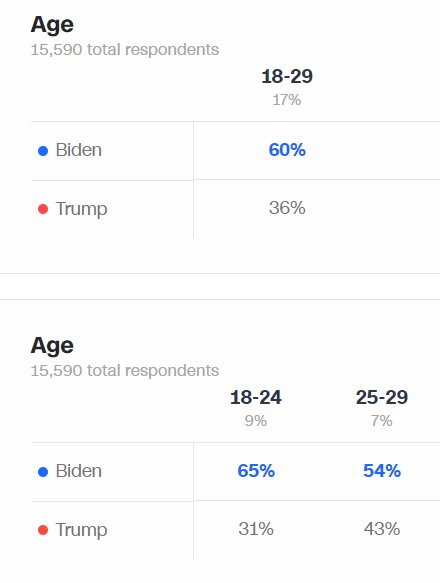

2022
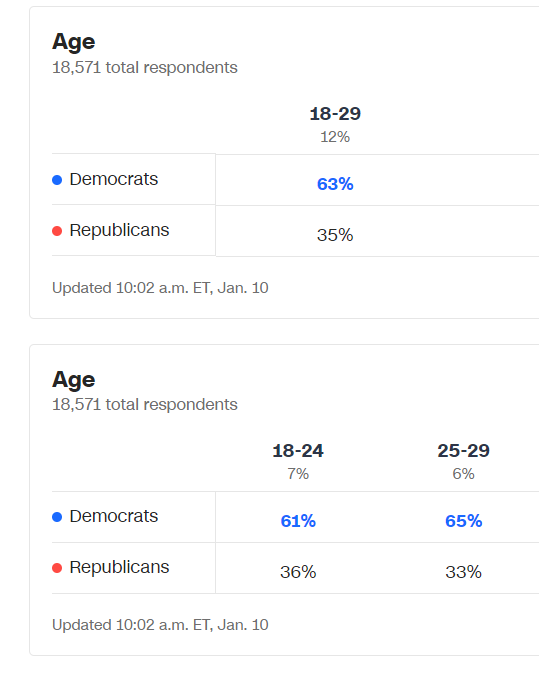

2018
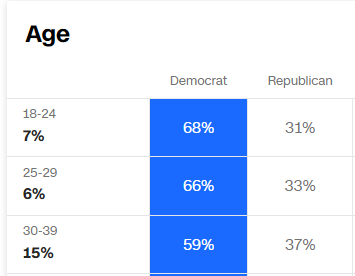

The growing gender gap among young people
https://www.brookings.edu/articles/the-growing-gender-gap-among-young-people/
snip
In politics, we are seeing a gender gap amongst today’s youngest voters—aged 18 to 29—with young women being significantly more Democratic in their political leanings than young men. For instance, a recently released national poll by the Institute of Politics (IOP) at Harvard Kennedy School finds that among 18 to 29-year-olds, President Biden’s lead with women is +33 points in contrast to young men where his lead drops to a mere six points. When compared to this stage of the 2020 campaign, Biden’s lead among women was nearly identical (+35), while his lead with men stood at +26, representing a steep drop in just the past four years.
When it comes to party identification, Democrats have again lost significant ground with young men. In 2020, 42% of young men in Harvard’s poll identified as Democrats versus 20% who identified as Republican. Now, 32% are Democrats and 29% are Republicans, with the number of independents remaining relatively unchanged. Women over the same period have not moved as much. In 2020, 43% of young women in Harvard’s poll identified as Democrats, and 23% were Republicans. Now, 44% are Democrats, and 18% are Republicans. Meanwhile, a recently released Link to tweet
" target="_blank">Economist/YouGov survey shows a staggering rise in support for Donald Trump among young people. In fact, the rise in Trump favorability among the young outstrips the rise in favorability among all other groups in the population except Democrats and liberals. We should view these polls with caution, especially because the subgroups are often too small to be statistically significant.
There are other indications of a growing gender divide among young people that goes deeper than just politics. For instance, a longitudinal analysis by international research agency Glocalities between 2014 and 2023 highlighted the growing rift in Gen Z. It found that young women have become significantly more liberal and embraced “anti-patriarchal” values over the last decade, while young men have stayed relatively the same. Additionally, it showed that young men have been the slowest among all groups to move towards more liberal values over the nearly 10-year period. Glocalities found young women are most concerned about issues like “sexual harassment, domestic violence, child abuse and neglect, and mental health problems.” Men were generally more focused on “competition, bravery, and honor.” The study found young men have become more patriarchal in their orientations overall when compared with women and even older men.
The analysis further linked “feelings of despair and societal disillusionment, a focus on patriarchal values, and rebelling against cosmopolitan liberal values” to the growing rise of the radical right. This leads many to fear that as young men are resisting the tides of change, they may be vulnerable to far-right groups and movements who promise a return to more patriarchal systems which offer a break from the social developments which they believe have begun to unfairly work against their societal interests. Gallup recently studied the gender divide and found roughly 25% of men aged 18 to 29 identify as ??liberal,” versus 40% of women in the same demographic—up from 28% in 2003. Men were found yet again to be relatively unchanged in their self-identification during that timeline.
snip
